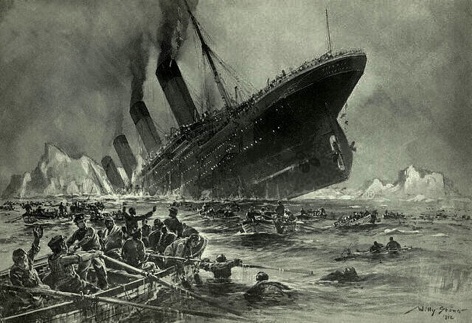
The Titanic sank on 15 April 1912, and the subsequent enquiry by the US Senate was obviously of great interest to our predecessors: every issue of the following month contains articles covering the proceedings. One aspect where we sympathise with the editorial staff of the day is their despair over the coverage of the disaster in the newspapers: it seems that sensationalism, over-simplified reporting and inaccurate leaks were as much of an issue a century ago as they are now.
This particular article, which can be read here, discusses a letter published in The Times by Sir William White, who was a reknowned naval architect and former Chief Constructor at the Admiralty, during which time he was chief designer on 245 warships; he was also a consulting architect on the liner Mauretania, the fastest ship in the world until the launching of Titanic’s sister-ship, Olympic.
White, who had overseen inquiries into several ship losses, had written to The Times concerning the energy dissipated when the Titanic struck the iceberg, and the questions that raised over the engineering of the ship. This, he had said, was likely to be the most important consequence of the enquiry, rather than the issue of provision of lifeboats, which had dominated discussions of the tragedy — as indeed it still does.
‘The general public, impressed by a single idea, has clamoured restlessly for more lifeboats,’ the article said. ‘To it the only fact of importance is loss of life, and since in this particular case more lives might — we ask attention to the word “might” — have been saved, it demands more boats.’ But for engineers like White, it adds, attention should go in ‘other and better directions’, particularly how to avoid collision with icebergs altogether, and to ensure that if they do occur, they don’t sink the ship.
“The general public, impressed by a single idea, has clamoured restlessly for more lifeboats
This, it says, is a matter of compromise. If the Titanic had been going more slowly than its speed of 21.5knots, it would have had more time to steer to avoid the iceberg, and if it had hit, it might not have caused as much damage. ‘But that a modern liner should travel at so low a speed as ten or eleven knots for a whole night is inconceivable,’ it says. ‘It would not be tolerated; passengers would rather run the very distant risk of colliding with an iceberg.’
White had said — and The Engineer agreed — that the answer was to improve the water-tight subdivision of ships. The use of transverse compartments — that is, running the width of the ship — in the Titanic had obviously not worked; future designs should include longitudinal compartments, running from bow to stern, as well.
The Engineer agreed. ‘For ourselves,’ it said, ‘we would rather see the number of boats reduced to the minimum required for service, and the safety of the vessel itself raised to the maximum, than see a vessel below the maximum of safety loaded with boats.’




Glasgow trial explores AR cues for autonomous road safety
They've ploughed into a few vulnerable road users in the past. Making that less likely will make it spectacularly easy to stop the traffic for...